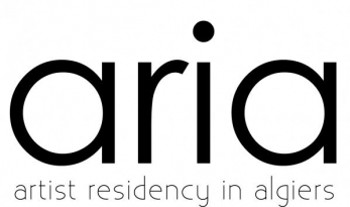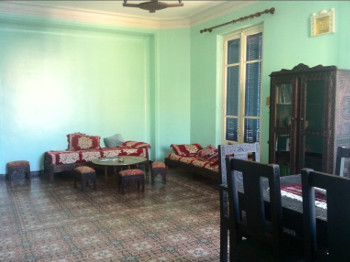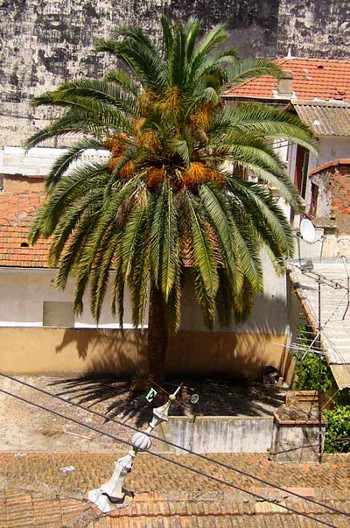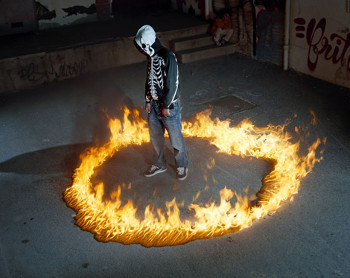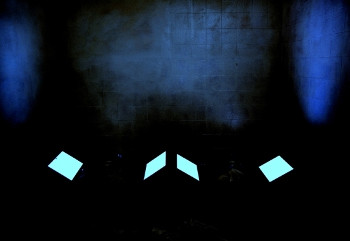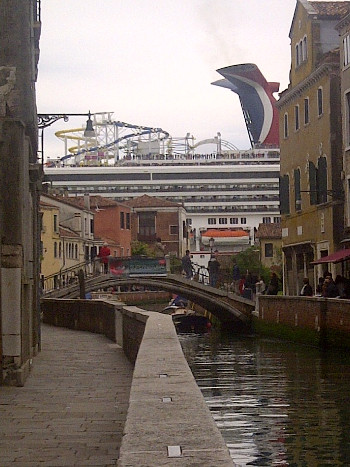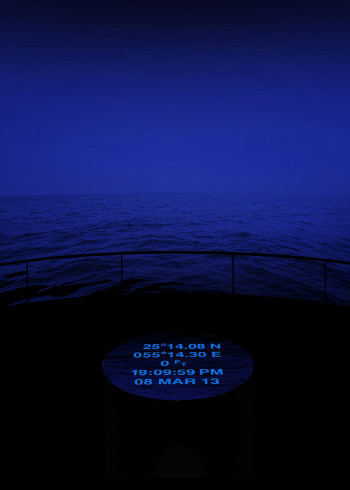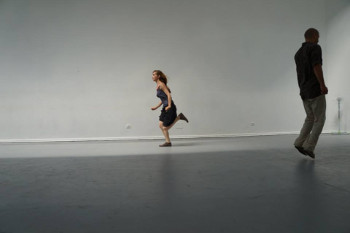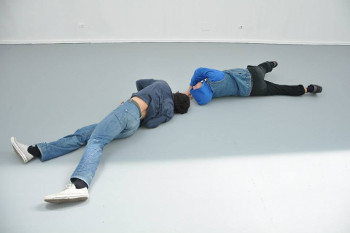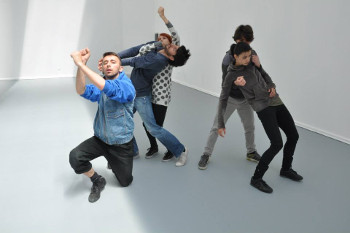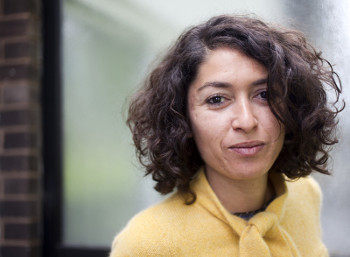Yasmina Reggad and
Bérénice Saliou are two young curators who work between Europe and North Africa. In the last few years, they have both initiated residency programs for the mobility of artists in the Mediterranean area.
We met during the opening days of the Venice Biennale and tried to get their point of view on the 55th International Art Exhibition.
Not only we were interested in their opinion as - given their age and geographical location - they are incurring the risk of finding themselves in the middle of a huge socio-political change which will involve us as well, but also because their curatorial work highlights the production processes, rather than the exhibitory ones.
From our perspective, with this interview there emerge both the impulses and the contradictions of those who, like Yasmina and Bérénice, work in the so-called emerging markets: between the will of being recognized on a global level and the urge of giving an answer to the characteristics of the territory. At the same time, it is evident how their answers indicate the possibility of telling and living the geography of contemporary art in many different ways.
First of all, can you tell us about the type of work you are carrying on with Aria in Algeria? We have found it really interesting, that you are working to build new reference point for the arts and also aiming to create a diffuse kind of platform, beyond your national territory.
Yasmina Reggad: To start with, it is important to give a better idea of the context in which we have been evolving. Algeria is little known in general, and in the art world in particular.
There exist obvious socio-political reasons and the decade of terrorism in the 90s was certainly the main one. However, the country has always been celebrated for its wealthy literature and cinema.
Although artists of the Diaspora or of Algerian origins are actually well-known (aria's founder Zineb Sedira, Kader Attia, Mohamed Bourouissa, Adel Abdessemed, Neil Beloufa, Fayçal Baghriche, Yazid Oulab, to name some), the thriving yet humble Algerian art scene has been overlooked in general. Said this, aria (artist residency in algiers) is a research-oriented residency program based in Algiers (Algeria), founded by artist Zineb Sedira in 2011 and officially started in 2012. We invite emerging and established artists from the Maghreb region and beyond, to conduct research related to the country or to develop their ongoing practice and processes by engaging with certain aspects of Algeria. We also like to call it " an invitation to artists to think or develop new work inspired by a singular experience".
Starting from this year, we have addressed issues related to the lack of opportunities of Algerian artists in producing and exhibiting their work within and outside Algeria, and have developed a program of commissions to Algeria-based artists. Commissioned by aria, Atef Berredjem is currently developing a new work curated by Nora Razian while, for aria's special projects' space at 1:54 Contemporary African Art Fair in London, I am curating an installation by Amina Menia. In addition, we are also developing our exhibitions projects with 'The Economy of Hope' (featuring artists Amina Menia and Mohamed Bourouissa), which I am curating, opening in April 2014 at Selma Feriani Gallery in Tunis (Tunisia). Our first objective is to become a 'reference point for the arts' in Algeria.
And how -if doing so- are you looking at Europe?
Yasmina Reggad: As Zineb and I are both based in London, by definition we also act as intermediaries and so does aria, as a platform to interact beyond the borders of Algeria. Another one of our goals is to (re)connect 'horizontally' with our neighbor countries, by systematically inviting artists from the Maghreb region to undertake a residency in Algiers.
Artists from that region traditionally meet mainly in France, or through French contacts. I can't even say that we are literally looking at Europe, as we are trying to impulse a collective dynamic in visual arts in the Maghreb region. Nonetheless, we are aware of the lack of opportunities for artists in Algeria (and in the Maghreb) to develop their practice while participating and having access to the art produced elsewhere.
In the same way, aria exists because it is important in the artists' process to travel and dialogue with other cultures, to network, to get inspired, to have the time to research and to produce work, which we understand as being a basic need for Algerian artists. That's the reason why we are looking at partnerships with other residency programs to facilitate opportunities for Algerian artists. For example, this was the case with Villa Romana in Florence, where artist Sofiane Zouggar spent two months this year, and Atef Berredjem two weeks in the summer.
There are so many talented artists in the Maghreb region, and these are challenging and critical times for "private" initiatives -like TRANKART, the Cinemathèque de Tanger, La Source du Lion in Morocco, the artists-run space Box 24 in Algiers, the coming House of Photography in Tunis- or even commercial endeavors, such as Tunis-based Selma Feriani Gallery, to support these young contemporary art scenes.
So, in the end, it is also time for Europe to come to them.
From your point of view, does the Biennale still represent a model for the artistic and cultural production?
Yasmina Reggad: This was my first trip ever to Venice, and to the Biennale. I've eventually decided to take such trip to make an experience of my own, after having flipped through many reviews and catalogues of the previous editions from my London desk. Having reached its 55th edition, the Biennale has now been held for more than a century: yet, if still considered a model, I would be worried.
What type of model are we talking about? Do we want to consider the format, the set up, the content or rather the success in terms of exposure, audience and market?
I believe that in terms of curatorial format many ideas have been 'experimented' in Venice, such as monographic and thematic exhibitions, single or multiple curatorships, at times geographically focused or showcasing emerging artists, 'fringe' pavilions and so on. What I noticed for sure is that the Biennale has been curated and directed by more men than women.
Overall, if looking at the possibility that Venice was a first mover in everything mentioned, then it should surely stand out as both a valuable experience and a lesson for all of us.
Nevertheless, another impression of mine is that for an art scene to exist somewhere in the world - and consequently, for the establishment of an art market - there is the urge for a biennial.
So is that the model in question? There are so many biennials nowadays, that I haven't figured out, yet, if they are called biennials for they happen every second year or because they are paying tribute to Venice. Among these, the only one I have attended which actually keeps the model of national pavilions is the Biennial of Alexandria. I thought it was an obsolete idea, considering that nowadays artists are so global that they can no longer represent any kind of flag.
With regard to other biennials I visited, as those in Latin America, the Gulf or in Europe, I have to say that they are instead large-scaled, international temporary exhibitions. I couldn't say precisely what they might owe to the Venice Biennale. I would like to read more on the socio-historical context of the Biennale, as if it were a monument of art history, focusing both on the Italian local context and in the international state of the art, and always from an Eurocentric point of view.
In which sectors do you believe the Biennale should be investing more? Could you present some best-practice models in this sense?
Yasmina Reggad: Again, the Biennale has been running for more than a century. Consequently, I believe they are trying to respond to both the professional and general audience' demand.
In the context of this 55th edition, I was expecting more works to be specifically commissioned by the director Massimiliano Gioni, for his Encyclopedic Palace. I was surprised to see very few of them, if compared to the overall amount of artworks presented, but I suppose it was a matter of resources. This last point might also answer my questionings whilst reading the exhibition labels, which I found confusing when using terms as "commissioned by" (or was it for?), "produced by some gallery" and "thanks to the support of that institution".
I didn't have the impression of the Biennale Foundation getting really involved as a commissioner, but rather that of artists themselves taking advantage of either a fantastic invitation, either a world famous platform to produce new work, which was sometimes vaguely related to the curatorial rationale. It also lacked the presence of live events such as the selection of performances. Moreover, The Encyclopedic Palace being research-based exhibit, I would have appreciated talks and conferences around the issues it addresses, in order to obtain some kind of knowledge production.
Lastly, I have often read that the Biennale is not fairly representative of the global state of the art. While visual arts are booming in the Middle-East and North Africa, one is surprised to see such few artists from those regions in the International Art Exhibition. I am always concerned that this could create a misunderstanding implying the absence of relevant art-related practices in some regions of the world. And, as for the national participations, I still find it an aberration, despite understanding that they offer a once-in-a-lifetime opportunity for an artist.
Most of the elements I could not find in the Biennale, I could find in the so called 'Collateral Events' where I believe "collateral" has also taken the full sense of one of its meanings: "serving to support".
During the last editions of the Biennale, there have emerged many events officially aimed at investigating the "Arabian culture". Not only we have seen the birth of national pavilions, such as the Emirates'- but there was also a great feedback among the collateral events, with exhibitions such as "The Future of a Promise" (Edge of Arabia, 2011). Do you think the adjective "Arab" is effective in representing a common cultural base? How would you judge, partially or overall, such initiatives?
Yasmina Reggad: This question about being 'Arab', or being perceived as such is so good it would need more than a single interview to be addressed - and I am certainly not entitle to answer it alone.
Isn't it the way we call the art (or the people - including myself) from whatever country or culture it includes, as opposed to the Western World?
In my opinion, as long as there won't be a fair representation of the diversity of practices (where geography is not taken into consideration), and that artists are considered according to their origins, this kind of denomination, along with the necessity for this kind of specific exhibitions, will exist. Anyway, wasn't it already the case with African art and Latin American art?
From a more subjective perspective, what we wish to achieve with aria is to see Algerian artists participate in art projects because they are artists.
Letting aside the exposition itself, do you find that the Biennale is offering concrete occasions for networking? What is the added value of being around during the opening days, for someone of the sector?
Yasmina Reggad: Obviously, when hearing that the whole planet of art meets there, one attends the opening week also motivated by network opportunities.
Personally, I was delighted to pack my flip flops and summer clothes, thinking that I would have been a tourist of the arts and catch this opportunity to meet some friends and colleagues. The opening week fulfilled its promises: the whole world of art didn't miss the party. On the contrary, I kind of did, as I found everything much more exclusive than what I had thought and, also, it was quite frightening to see all these people running after… after what actually? Indeed, nobody truly had the time for developing consistent theories and critical reviews over a quiet dinner.
Meetings, openings, parties, breakfasts, Aperol, celebrities, the last artwork of some artist that some art critic had sentenced it was not-to-be-missed, getting lost around the city and always ending up in the dead-end of a canal, not to mention the mouthfuls of gossips. As for myself, I religiously went to all the shows and observed. I spent six days in Venice without investing too much in networking and I have barely seen 50% of what was on offer. Despite this, although by chance, I did make some precious contacts myself - especially related to funding opportunities.
Overall, I believe that for newcomers and young curators, as I am, the trip is worth the networking. Undoubtedly, one needs to prepare a long time in advance and once in site, be armed with courage, positive attitude, determination and also with what in French is called a "strombinoscope", i.e. a sort of employees' profile directory. I also have had the feeling that one needs toe ready with something to promote or to sell, be it themselves as artists or an institution.
Funnily enough, Facebook and Twitter appear to be effective tools in order to find out "who's going where" as everybody is so excited - and the city in such state of siege during the opening week- that their travel plans are published six months in advance. In the end, two trips might be a fair, although pricy, compromise between work and enjoying the city and the art.
Could you tell us about a work of art or a project that you have found of particular interest during this Biennale of Venice?
Yasmina Reggad: It is hard to answer, as my first time at the Biennale has been such a rich experience. I really enjoyed the performative work developed by the artists of the Romanian Pavilion who, in a very ironical and witty way, reenacted different works presented during the Venice Biennale, since its inception. Then, in a glimpse - as it kind of opens the Arsenale exhibition - I could easily guess that 'Grosse Fatigue' by Camille Henrot was a winner. It was a work I extremely liked.
Finally, considering the hours-long queue in front of the Prada Foundation, I feel very fortunate to have seen 'When Attitude Becomes Forms' without too much effort. I felt even luckier to spend most of the visit deciphering the ground floor cabinets of correspondences, sketches and other well-archived documents coming from the Kunsthalle Bern. And there, my luck was due to having visited the exhibition with a German speaker. My highlight was a priceless letter of Harald Szeemann's mother, where she implores her son to stop an infamous controversy caused by a grotesque exhibition of his, fearing that he would lose his job.
Interview with
Bérénice Saliou
Yasmina Reggad, graduated in History from the Sorbonne University. She is an independent curator and writer based in London, and works between London, Paris and Algiers.
Since January 2012, she is Programme curator at aria (artist residency in algiers). Current curatorial and research projects include 'Sketches of Algiers' by Amina Menia for aria's project space at 1:54 Contemporary African Art Fair, London, UK(October 2013) and 'The Economy of Hope' with Amina Menia and Mohamed Bourouissa at Selma Feriani Gallery in Tunis.
Past projects include 'Ce n’est pas du sang, c’est du rouge' with Gohar Dashti and Shilpa Gupta (2012) and 'Mitosis' with Jonny Briggs (2012), both for the White Project Gallery, Paris.
She is also the Director and Founder of the non-profit organisation, Photo-Festivals, London for which she initiated and curated the artist residencies, development and public programmes. She publishes essays and articles on photography and contemporary art, takes part in several juries, and is regularly called upon to participate in panel discussions and talks for organisations and galleries such as the National Photography Symposium, Cornerhouse in the UK, Sharjah Art Foundation March Meeting in the UAE, or Casa Tomada in Brazil.
Francesco Urbano Ragazzi is a curatorial duo founded in 2005. Invited to the Cité Internationale des Arts by the Mairie de Paris in 2008, FUR subsequently started to curate residency formats: Spot – studio dal vivo, promoted by the City Council of Venice (2010); Mirroring, funded by the Emirates Foundation (2011); Prima Visione, for the National Gallery of Cosenza (2013). During the same period, they were also included in the curatorial team of Art Enclosures, residencies for African artists instituted by the Fondazione di Venezia. Always based on a workshop practice, there are some recent expository projects such as the Internet Pavilion of Miltos Manetas for the Venice Biennale (2011 and 2013), Io Tu Lui Lei at the Bevilacqua La Masa Foundation (2012), L' Ile Flottante, as a section of the fourth Sinopale (Sinop Biennale, 2012).


